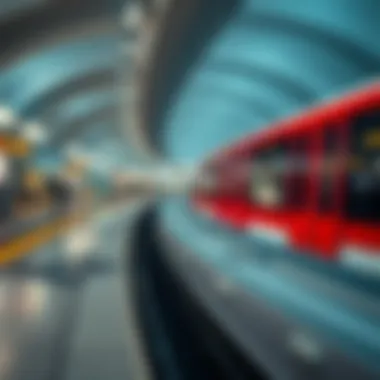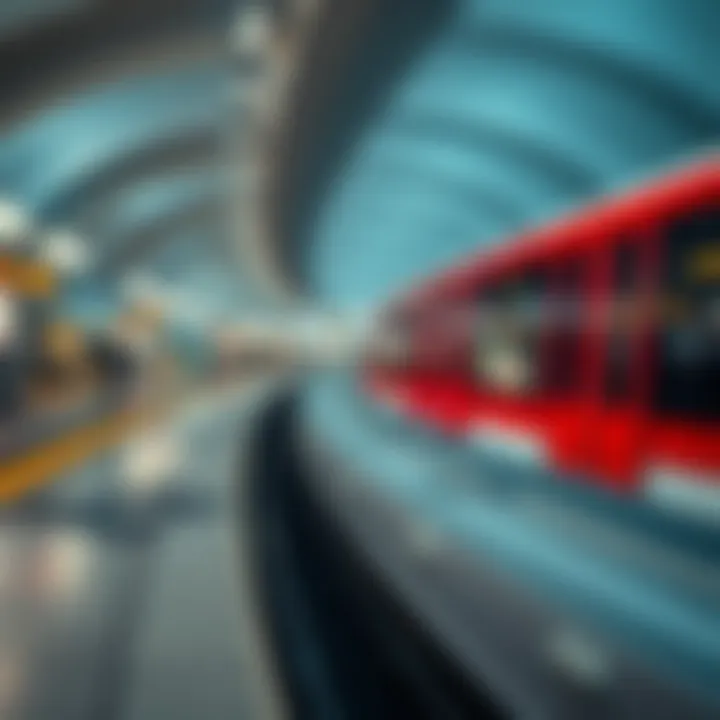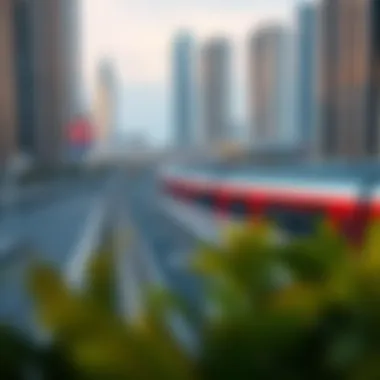Understanding the 2023 Dubai Metro Map


Intro
With the bustling skyline of Dubai as a backdrop, the 2023 Dubai Metro map weaves an intricate web of convenience and accessibility across the city. This transport system, which has become a lifeline for residents and travelers alike, is not just about getting from one point to another. The metro embodies the rapid growth and urban evolution of Dubai itself.
Since its inception, the metro has continuously adapted to the increasing demand of a vibrant city teeming with life. The 2023 refresh of the map provides a clear visual guide that reflects changes in routes and stations. It signifies a commitment to enhancing connectivity, showcasing the development of residential and commercial hubs along the corridors of the metro lines. As such, understanding the implications of the metro's layout for real estate trends and urban development becomes crucial for investors and residents.
As we delve into the intricacies of the 2023 Dubai Metro map, we will explore how this public transport system aligns with key economic and housing trends. The importance of the metro reaches beyond mere transportation; it shapes the landscape of Dubai—from skyrocketing property values to burgeoning neighborhoods.
Embarking on this journey through the metro map not only illuminates its current operational framework but also uncovers future projections for urban expansion and property market shifts. Whether you are an investor eyeing the next opportunity or a resident seeking the most efficient way to navigate the city, this comprehensive guide aims to provide all the insights necessary to make informed decisions.
Overview of the Dubai Metro
The Dubai Metro stands as a testament to the city’s rapid growth and forward-thinking approach to urban transportation. It plays a pivotal role in not just easing traffic congestion but in shaping the urban landscape and enhancing the quality of life for residents and visitors alike. In this ever-expanding metropolis, the metro system is not merely a means of transportation; it is a critical component of the city’s infrastructure that connects different neighborhoods, business districts, and tourist attractions, fostering an environment of accessibility and convenience.
History and Development
The journey of the Dubai Metro began in the early 2000s, in response to the increasing traffic woes stemming from the city’s explosive population growth and urbanization. The plan was ambitious. It aimed to build a comprehensive and efficient rail network that reduces reliance on private vehicles. The construction kicked off in 2006, and by 2009, the first stretch of the Red Line was opened to the public. This marked a significant milestone in Dubai’s transportation history, paving the way for future developments.
The Metro witnessed steady expansion, with both the Red Line and the Green Line being extended over the years. This evolution reflects the city’s commitment to providing sustainable public transport solutions. Over a span of years, numerous stations were introduced, integrating seamlessly into the urban fabric. Today’s Dubai Metro represents years of strategic planning and implementation, enabling smoother transit options across the bustling city.
Current State of the System
As of 2023, the Dubai Metro operates two main lines: the Red Line and the Green Line, complemented by the newly introduced Purple Line. This latest addition emphasizes the city’s vision for enhanced connectivity, catering not just to commuters but also to the tourism sector. The metro system, with over 50 stations, facilitates millions of passenger trips every month. Each train is equipped with advanced technology and boasts a modern design, ensuring a comfortable ride.
Moreover, the system operates with impressive punctuality, making it a reliable choice for daily commuters. With user-friendly ticketing systems, including mobile apps and smart NOL cards, navigating the metro has become straightforward. The stations are designed to accommodate the needs of all users, including those with disabilities, reflecting a commitment to inclusiveness and accessibility.
Key Milestones
The history and development of the Dubai Metro have been marked by essential milestones that highlight its growth and success:
- Inauguration (2009): The Red Line officially opened, marking the beginning of Dubai's metro journey.
- Green Line Launch (2011): This line went live, connecting several key areas in Dubai and enhancing travel options for commuters.
- Extensions (2014-2020): Both the Red and Green Lines underwent extensions, increasing the number of stations and reducing travel times significantly.
- Introduction of the Purple Line (2023): This latest project aims to connect previously underserved areas with the existing network, showcasing Dubai's commitment to comprehensive urban mobility.
"The Dubai Metro is not just a transport system; it’s a connection to the future, designed to enhance every journey taken within this vibrant city."
As we explore the 2023 Dubai Metro map further, it becomes evident that the system is not only about getting from point A to B; it's about fostering a community, enhancing urban growth, and transforming the way we navigate this dynamic city.
The Metro Map
The 2023 Metro Map is more than just a guide for commuters; it represents a significant leap in Dubai's transit evolution. The updates made to this map, both in terms of new routes and station enhancements, reflect the city’s commitment to providing an efficient and user-friendly transport system. As more people flock to Dubai for work or leisure, having a clear understanding of the metro layout is crucial not only for daily commuters but also for investors and homeowners looking to capitalize on the city’s growth.
Overview of New Routes
One of the standout features of the 2023 Metro Map is the introduction of new routes that connect vital areas of the city. For instance, the addition of the Route 2020 extension has increased accessibility to Expo 2020 site, linking it directly to the existing metro lines. This move is essential for enhancing transport options, especially for those who might not own a vehicle.
New routes also cater to burgeoning neighborhoods, providing easy access for residents and adding value to properties situated around them. Cities develop around how easily people can get from point A to point B, and with these new additions, Dubai's urban fabric is quickly maturing into a well-connected network.
Updated Stations


With the new routes come updated stations, equipped with modern amenities. Stations like the Dubai Marina and Al Furjan are now designed with comfort in mind, including waiting areas, digital info boards, and retail spaces. The aim here is to transform the wait into a more pleasant experience, shifting the perception of transit stations from mere stops to vibrant community hubs.
Moreover, the capacity of these stations has increased significantly. For example, the Jumeirah Lakes Towers station can now accommodate more passengers during peak hours, which means fewer bottlenecks and a smoother commuting experience overall. _In districts where real estate is booming, these upgrades also signal to potential buyers that their living conditions are directly linked to accessibility, so properties nearby might see an uptick in interest.
Transfer Points and Connectivity
Transfer points are the backbone of efficient transit systems. The 2023 Metro Map emphasizes enhanced connectivity between existing transit lines. Key transfer stations like Burj Khalifa/Dubai Mall and Union Station have had their layouts revised to streamline connections between metro and tram lines. This makes switching between modes of transport nearly seamless, saving precious time for commuters.
Furthermore, the inclusion of future bus routes around these transfer points boosts overall accessibility. A commuter can travel across the city without much hassle, making public transport not only viable but preferable to driving. For expatriates considering long-term stays or investments, understanding this connectivity can illuminate potential housing choices, as areas near these junctions typically experience higher demand.
**"Highly connected transport routes lead to higher property values. This is a key insight for those looking into real estate in rapidly developing areas."
In the end, the 2023 Metro Map represents more than just routes and stations; it mirrors Dubai's dynamic growth and development. As the city’s infrastructure evolves, so does the lifestyle and opportunities for the people that call it home.
Impact on Urban Mobility
The impact of the 2023 Dubai Metro on urban mobility is significant and multifaceted. As various aspects of city life gain relevance with increasing populations, it becomes clearer that effective public transport systems, like the metro, play a pivotal role in shaping the daily experiences of commuters. In Dubai, this development isn't just about transportation but extends to economic growth, social exchange, and broader environmental changes. With the introduction of new lines and stations, mobility has become more seamless and efficient, catering to the needs of residents, tourists, and businesses alike.
Enhancements to Commuter Experience
One of the standout features of the newly updated metro system is the various enhancements aimed at improving the commuter experience. For starters, the introduction of state-of-the-art train designs makes journeys more comfortable. These trains now include wider aisles and designated areas for standing, making them more accommodating during peak times. Moreover, the addition of digital displays showing real-time updates ensures that passengers are kept in the loop, thereby reducing anxiety about delays or changes in schedules.
Furthermore, the metro stations themselves have seen significant overhauls. Enhanced facilities such as clean waiting areas, more ticket machines, and dedicated spaces for families and people with disabilities reflect a focus on user satisfaction.
"An efficient transit system can transform daily commutes into more manageable, enjoyable experiences."
More direct routes to major business districts and tourist attractions also mean less travel time and frustration for users. It's no small feat to navigate a sprawling city like Dubai, so these enhancements hold immense value.
Environmental Considerations
As urban areas expand, sustainability becomes a pressing concern. The Dubai Metro embraces eco-friendly practices that align with global environmental goals. One significant element is how public transport reduces car dependency. With more people choosing the metro, traffic congestion decreases, leading to lower carbon emissions. Additionally, electric trains are inherently more sustainable than traditional diesel options, further minimizing the environmental footprint of commuting in Dubai.
Moreover, the metro system encourages the development of pedestrian-friendly areas surrounding stations. Enhanced walkability not only boosts local businesses but also promotes a healthier lifestyle among residents. It isn't just about moving people from point A to B; it's about nurturing an eco-conscious community where progress doesn't come at the expense of nature.
In summary, the dual focus on enhancing commuter experiences and prioritizing environmental sustainability represents a balanced approach to urban mobility in Dubai.
Real Estate Implications
The real estate landscape in Dubai stands at a crucial juncture, with transportation networks like the Dubai Metro playing a significant role in shaping property dynamics. Understanding how the latest developments in the metro system affect real estate is crucial for investors, homeowners, and expatriates alike. As urban mobility improves, so too does the potential for property value appreciation and investment opportunities. The connectivity offered by the metro not only makes commuting easier but also enhances the desirability of neighborhoods, a vital aspect for prospective buyers and investors.
Influence on Property Values
Location, location, location – in real estate, this adage can’t be stressed enough. The proximity to metro stations is becoming a decisive factor for many buyers. Areas surrounding newly constructed metro stations tend to see a surge in property values. This can be attributed to the increased accessibility that metro provides, making it easier for residents to commute to work, schools, and leisure destinations.
Consider neighborhoods like Dubai Marina and Downtown Dubai; property values in these areas have consistently risen due to their connection to metro stations. In fact, areas that see expanded metro access often experience a lift in market demand, resulting in rapid appreciation of property prices. Despite a certain degree of market fluctuation, as the metro expands its reach, the trend is expected to remain upward.
"Proximity to Dubai Metro stations has become a powerful selling point for developers and real estate agents alike."
Investment Opportunities


The evolution of the Dubai Metro unveils a treasure trove of investment opportunities. New stations accessible to previously underserved regions open up possibilities for residential and commercial developments. Investors should particularly focus on properties that lie within close reach of metro lines, as this connectivity attracts renters and buyers who prioritize ease of transport.
Recognizing where the next metro stop will be can provide insight into future property appreciation. For instance, emerging neighborhoods located near the planned extensions of the metro network are poised for growth. Here are some considerations for discerning investors:
- Look for up-and-coming areas: Target communities that are on the brink of development.
- Assess rental demand: Higher accessibility usually leads to greater tenant interest.
- Focus on mixed-use developments: Projects that integrate residential, commercial, and retail spaces can maximize returns due to increased foot traffic from metro users.
Neighborhood Dynamics
The introduction of new metro stations can drastically alter the fabric of neighborhoods. Areas that were once considered remote or undesirable can pivot into bustling hubs of activity. This evolution often brings about not only higher property values but also significant demographic shifts.
As easier access to the metro encourages more people to settle in these neighborhoods, we observe a diversification of the population, which can enrich local culture and amenities. Urban developers are increasingly focusing on creating vibrant communities that cater to a mixed demographic. This approach offers:
- Enhanced lifestyle options: New restaurants, cafes, and recreational facilities often emerge in metro-adjacent areas.
- Community development: As neighborhoods bloom, there is a communal vibe that can enhance social interaction and support local businesses.
Future Expansion Plans
As Dubai continues to grow at a dizzying pace, so does the need for an efficient transportation network. The Dubai Metro has not only established itself as a crucial player in urban mobility but also serves as a catalyst for the city’s future development. Future expansion plans of the metro system are essential not just for enhancing connectivity but also for driving economic growth, improving property values, and ensuring sustainable urban development. Without a doubt, these plans can shape realities for investors, homeowners, and developers in the ever-evolving landscape of Dubai.
Upcoming Projects
Several exciting projects are on the horizon that aim to expand the reaches of the Metro, making it more accessible to a greater population. The upcoming Purple Line, for instance, will traverse key residential areas along Al Shindagha, connecting to beach amenities and landmarks like the Dubai Frame. Furthermore, significant plans are in place for additional extensions from existing routes.
- Expansion to Dubai Marina: This particular project targets beach-loving commuters who regularly travel to the Marina area, transforming daily commutes into seamless journeys by reducing traffic congestion.
- Linking to Expo 2020 Venues: Though Expo 2020 may have concluded, its legacy is cementing a lasting metro connection to the site. The Dubai Metro will provide real-time access to the International Specialty District and the Sustainability Pavilion.
These projects are not merely infrastructure additions; they are bold investments in the future of urban living that promise to bring neighborhoods closer, reduce travel times, and ultimately, enhance the quality of life for all residents.
Long-Term Urban Development Goals
As Dubai eyes the future, its metro expansion dovetails seamlessly with long-term urban development goals. The strategy is not just about laying tracks; it’s about crafting a holistic urban ecosystem where public transport is at its core. One might think of the metro system as the heart of a vast body, circulating energy, growth, and connectivity throughout the city.
Several key goals guide these expansion plans:
- Sustainability: Aiming for reduced carbon footprints through increased use of public transport instead of cars. Future expansion will focus on leveraging technology to introduce green energy solutions for the metro operations.
- Increased Accessibility: By expanding the metro into less densely populated areas, the plan aims to create equitable access to public transportation for all citizens and expatriates. New stations will be designed with accessibility in mind, allowing easy entry for disabled passengers and families with strollers.
- Economic Growth: Enhanced metro connectivity attracts businesses and investments into previously underserved areas. The ripple effect can lead to job creation and overall enhancement of local economies.
- Urban Integration: Metro developments are envisioned as part of larger urban planning efforts that include parks, residential units, and commercial hubs, effectively creating vibrant communities around transit hubs.
"The future of the Dubai Metro resides not only in extension of lines but in reshaping lives and neighborhoods through strategic planning and innovation."
Travel Tips for Metro Users
Navigating the Dubai Metro can seem daunting, especially for newcomers. However, with a bit of guidance, you can easily find your way around. Knowing the ropes is essential for maximizing your experience, whether you're an investor assessing real estate opportunities, a homeowner planning your commute, or an expatriate getting acquainted with the city.
Essential Information for New Users
For those who are fresh on the Dubai Metro scene, there’s a lot to grasp at first glance. Here are some fundamental tips that will make your travels smoother:
- Get a NOL Card: Before hopping on the train, make sure to purchase a NOL card. It’s a smart card used for fare payment and can be charged with varying amounts for different travel needs.
- Check the Timetable: The timetables are consistent but can vary on holidays. Most trains run from 5 AM to midnight from Saturday to Wednesday, and until 1 AM on Thursdays and Fridays.
- Understand the Zones: Dubai Metro divides the city into fare zones. Knowing which zone you’re traveling to will help you estimate your fare accurately, ensuring you don’t get hit with any surprises at the end of your journey.
- Download the RTA App: This handy app gives you real-time updates on train schedules and alerts, making it easier to plan your trips. Also, it includes options to track your NOL balance.
- Familiarize Yourself with Stations: Before you even step onto the train, get acquainted with the station names and their features. For example, if heading to the Burj Khalifa, make sure to disembark at the Burj Khalifa/Dubai Mall station.
Safety and Accessibility
Safety and accessibility are key elements when using the Dubai Metro. The system has made notable strides in ensuring it is inclusive for all passengers. Here’s what you need to keep in mind:


- Elevators and Escalators: All major stations are equipped with elevators and escalators, making it easier for those with mobility issues. Additionally, there are clearly marked signs to help those requiring assistance find their way.
- Dedicated Spaces: Trains feature designated areas for individuals with reduced mobility. These spots are located at the beginning and end of each train.
- Onboard Safety: The trains and stations are monitored by CCTV cameras for security. Always keep an eye on your belongings and report any suspicious activity to Metro staff.
- Traveling with Children: If you're traveling with childern, have them stay close by, as the trains can be quite crowded during peak hours. You’ll want to ensure your little ones remain safe and accounted for.
- Emergency Protocols: Familiarize yourself with emergency exits and procedures. While the system is designed to handle emergencies effectively, knowing the drill can instill peace of mind.
Remember, the Dubai Metro aims to be not just a transportation mode, but an integral part of the city’s urban fabric. By using it wisely, you enhance your travel experience and contribute to a more sustainable future.
Taking the time to understand these essential tips can drastically improve your experience, allowing you to focus on enjoying what Dubai has to offer rather than worrying about how to get there.
Comparison with Other Transportation Systems
Understanding how the Dubai Metro fits among other transportation systems is crucial not just for daily travelers, but also for investors and policymakers aiming to grasp the bigger picture of urban mobility. In a city like Dubai, where rapid growth and expansion are the norms, comparing its metro with regional and global transport systems helps highlight its strengths and weaknesses, thus serving as a benchmark for future improvements.
Benefits of Comparing Transportation Systems
- Efficiency Metrics: Time spent in transit, frequency of service, and ease of connections.
- Cost-Effectiveness: Economic implications for commuters; fare comparison with other systems.
- Environmental Impact: Comparing car emissions versus metro use, which helps promote sustainable city development.
When you stack the Dubai Metro against other public transport modes, it’s easy to see both the advantages and the areas needing improvement. While other systems may offer premium services in some regards, Dubai’s metro stands out for its reliability and technological advancements.
Regional Comparisons
Understanding the context within which Dubai’s Metro operates can be illuminated by comparing it to other regional transportation networks, such as those found in cities like Riyadh and Abu Dhabi.
- Riyadh Metro: Recently inaugurated, this network boasts extensive reach but is still developing its integration with existing transport modes. It features a phased opening, which contrasts with Dubai’s integrated operations from the get-go.
- Abu Dhabi Public Transport: Comprising buses and a planned metro system, Abu Dhabi’s transportation framework does not yet rival Dubai’s in coverage or frequency, making it less user-friendly for daily commuters.
This comparison shows that while the Gulf region is investing heavily in metro systems, Dubai has a head start that manifests in the efficiency of its service and the technology deployed.
Global Perspective
When you look at a global scale, how does the Dubai Metro measure up to transit giants like New York City’s subway or Tokyo’s rail system? Here are a few points of comparison:
- Service Frequency: The Dubai Metro offers a frequency that matches, and in many cases, outpaces those at peak hours in cities such as New York, where delays often occur.
- Sustainability Practices: Global cities like Copenhagen might be recognized for integrated bike transit, whereas Dubai focuses heavily on eco-friendly train systems and less carbon footprints.
- Technological Integration: Comparing with Tokyo, renowned for its punctuality and technological adeptness, Dubai is making strides in smart card systems and real-time tracking but still has room to grow in terms of overall user experience.
"A journey of a thousand miles begins with one step,” and when it comes to transport systems, taking that step requires regular assessments against regional and global norms, ensuring continual growth and innovation.
By exploring these comparisons, it becomes evident that while Dubai's Metro leads in many ways, the city must remain vigilant and adaptable to sustain its edge in the ever-evolving context of global urban transport.
Closure
The conclusion of this article serves as a significant anchor point, tying together the various insights we've explored throughout this comprehensive overview of the 2023 Dubai Metro Map. In understanding the implications of this transportation system, we emphasize not just its operational aspects, but also its transformative potential for urban mobility, real estate dynamics, and future expansion plans that mirror Dubai's ambitious urban growth strategies.
Summary of Key Insights
- Connectivity: The updated metro map showcases improved routes and stations that enhance connectivity to key landmarks, making it easier for residents and visitors to navigate the city with ease.
- Urban Mobility: The enhancements to the commuter experience signify a shift towards more sustainable and efficient urban transport solutions, reducing reliance on personal vehicles.
- Real Estate Impacts: Investment opportunities are ripe as new stations facilitate access to previously underserved areas, promising to elevate property values and attract development investments.
- Future Visions: Looking ahead, ambitious plans indicate that the metro system will continue to evolve, addressing the needs of a growing population while promoting sustainable city development.
Overall, the 2023 Dubai Metro Map is not merely a guide for commuters; it is a strategic tool for urban planning and real estate development that includes the considerations of varied stakeholders, including residents, investors, and urban planners.
Final Thoughts on Dubai's Metro Future
Reflecting on the future of Dubai's metro system, it becomes clear that the next phase will be driven largely by technological advancements and sustainable practices. The integration of smart technologies could further enhance commuter experiences, perhaps introducing features like real-time updates through mobile apps or AI-driven maintenance systems to ensure operational efficiency.
Moreover, as the city continues to grow, aligning with global best practices in public transportation will be essential to meeting the diverse needs of its expanding populace. Developing a comprehensive transport system that encompasses not just the metro but also other forms of public transit will likely be a key focus in the coming years.
In essence, the 2023 Dubai Metro Map is poised to play a pivotal role in shaping the future of urban transportation. By supporting sustainable development and embracing innovative practices, Dubai may set a precedent for urban mobility worldwide—making it a case study worth watching for cities around the globe.
"The evolution of the Dubai Metro is not merely a journey through stations; it's a pathway towards a sustainable urban future."
As we close this discussion, it’s evident that understanding the nuances of the metro's layout is crucial for anyone wishing to navigate the city efficiently and to grasp the broader context of Dubai's urban development. For a detailed exploration on Dubai's public transport initiatives, resources such as Dubai Roads and Transport Authority provide comprehensive insights.



